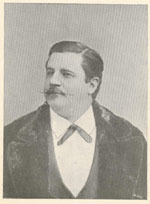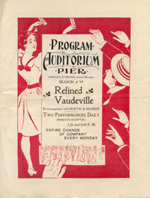The New York
Public Library for the Performing Arts > Vaudeville
Nation
Targeting an audience -- Haverly and Pastor
 Photographic portrait
Photographic portrait
of Tony Pastor.
Billy Rose
Theatre Collection
 Program cover, Auditorium
Program cover, Auditorium
Pier, Atlantic City, NJ,
for summer vaudeville
presentation
J. H. Haverly promoted the idea of combining a circuit of theaters
for his multiple productions. He was inspired by the newly available
railroad accessibility, so that he send his minstrel troupes, comic
combinations, circuses, and theater companies to the appropriate
theater for the ideal season. Contemporary cartoonists portrayed
him as a puppet master with toy theaters.
Tony Pastor had managed variety theater since opening his first
on the Bowery in New York city in 1865. He moved uptown to the Union
Square district in 1881. At that time, there was a "Ladies mile" of
department stores in the upper teens on 5th and 6th Avenue. It
was said that "from 14th Street down, the men were earning
it, and from 14th Street up, the women were spending it." He
recognized that he could attract an afternoon audience of the women
who had been shopping. He billed his theater as "refined vaudeville." Vaudeville
houses in cities and, especially, summer resorts followed his example. Vaudeville's major
competition, pantomimes and operettas based on nursery rhyme characters,
was damaged by the devastation of the Iroquois Theater fire in Chicago,
during the Christmas vacation of 1903.